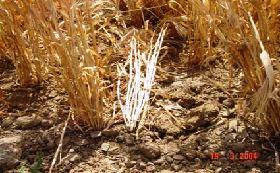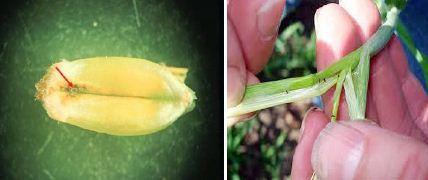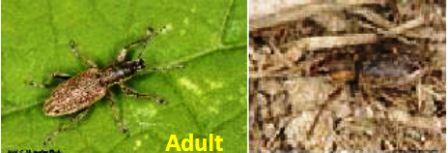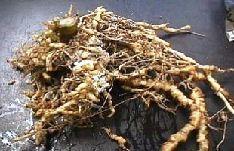Wheat: Insect, Mites and Nematode Pests Management
Wheat: Insect, Mites and Nematode Pests Management
Termites
Biology- Egg: Dull, kidney shaped and hatches in 30-90 days.
- Nymph: Moult 8-9 times and are full grown in 6-12 months.
- Adult: Creamy coloured tiny insects resembling ants with dark coloured head.
 Termites damage the crop soon after sowing and sometimes near maturity. They feed on roots, stem of growing plants, even dead tissues of plant feeding on cellulose. The damaged plants dry up completely and are easily pulled out. The plants damaged at later stages give rise to white ears. Infestation is heavy under unirrigated conditions and in the fields where un-decomposed farm yard manure is applied before sowing.
Termites damage the crop soon after sowing and sometimes near maturity. They feed on roots, stem of growing plants, even dead tissues of plant feeding on cellulose. The damaged plants dry up completely and are easily pulled out. The plants damaged at later stages give rise to white ears. Infestation is heavy under unirrigated conditions and in the fields where un-decomposed farm yard manure is applied before sowing.
American pod borer
BiologyIt is a polyphagous, infesting gram, lablab, safflower, chillies, groundnut, tobacco, cotton etc.
 Egg: The spherical, yellowish eggs are laid singly on tender parts and buds of plants. The egg period lasts for 2-4 days.
Egg: The spherical, yellowish eggs are laid singly on tender parts and buds of plants. The egg period lasts for 2-4 days.- Larva: Caterpillars are of varying colour, initially brown and later turn greenish with darker broken lines along the side of the body.
- The larval period lasts for 18-25 days. Body covered with radiating hairs. When full grown, they measure 3.7 to 5 cm in length. The full grown caterpillar pupates in the soil in an earthen cell and emerges in 16-21 days.
- Pupa: Pupation takes place inside the soil, pupal stage lasts 7-15 days.
- Adult: Moth is stout, medium sized with brownish/greyish forewings with a dark cross band near outer margin and dark spots near costal margins, with a wing expanse of 3.7cm.
- Young larva feeds on the leaves for some time and then attacks earheads. Internal tissues are eaten severely and completely hollowed out. While feeding the caterpillar thrust its head inside leaving the rest of the body outside.
- Fed leaves awns and earheads.
- Parasitoids: Tricogramma chilonis, Tetrastichus spp., Chelonus spp., Telenomus spp. (egg) Bracon spp., Ichneumon promissorius, Netelia product, Chrysoperla zatrowii sillemi, Carcelia spp., Ovomermis albicans, a nematode, Chaetopthalmus, Campoletis chloridae (larval), Lissopimpla excels, Ichneumon promissorius (pupal)
- Predators: Coccinellids, King crow, Braconid wasp, green lacewing, dragon fly, spider, robber fly, reduviid, praying mantis, red ants.
Aphids
Biology- Eggs: Eggs are dirty white in colour and laid along the veins of leaves.
- Nymphs: There are four nymphal stages (instars). The general appearance of each stage is similar except for increase in size during subsequent instars. The first, second, third and fourth nymphal stages last 1-2, 2, 2, and 3 days respectfully. The nymphs and the females look alike, except that the latter are larger. It breeds at a fast rate during cold weather and reaches the height of its population in February-March when the ears are ripening.
- Adults: Aphids are small, soft-bodied, pearl-shaped insects that have a pair of cornicles (wax-secreting tubes) projecting out from the fifth or sixth abdominal segment. Aphids are green colour. Both apterous (wingless) and alatae (winged) forms pass through 4-5 nymphal instars in their development and the nymphal period ranges from 5-7 days. Both the forms mate within a day or two after the final moult and start reproducing young ones. The apterous forms produce significantly more number of young ones than alatae but their life-period is shorter than that of alatae.
- In the field generally viviparous apterous forms are observed in large number.
- Like other aphids, the nymphs and adults suck the sap from plants, particularly from their ears. They appear on young leaves or ears in large numbers during the cold and cloudy weather.
- The damage is particularly severe in years of cloudy weather. A heavily manured, well-irrigated and succulent crop will harbour the pest for a longer period and suffer greater damage.

- Parasiotids: Aphidius spp., Aphelinus spp. etc.
- Predators: Syrphid fly, lacewing, minute pirate bug damsel bug and ladybird beetle, praying mantis, predatory thrips, rove beetle etc.
Brown mite
Biology Eggs: Hyaline, globular laid in mass. Eggs are generally laid beneath clods and are either active i.e. red in colour and not visible to the naked eye or dormant i.e. white eggs.
Eggs: Hyaline, globular laid in mass. Eggs are generally laid beneath clods and are either active i.e. red in colour and not visible to the naked eye or dormant i.e. white eggs.- Clearly visible on the underside of clods
- Nymphs: Yellowish in colour
- Adults: The mites are very small measuring about 0.5 mm in length, metallic brown to black with pale yellow legs and their forelegs are distinctively longer than the other three pair of legs.
- They feed on leaves by sucking sap by inserting two needle like stylets into the leaf there by withdrawing nutrients from the plants.
- Affected leaves become whitish and under severe conditions become reddish brown and bronzy
- Leaves wither and dry
- Predators: Oligota spp., Anthrocnodax occidentalis, Feltiella minuta etc., Green lacewings (Mallada basalis and Chrysoperla zatrowii sillemi), lady bugs.
- Predatory mite: Amblyseius alstoniae, Phytoseiulus persimilis. Predatory coccinellid beetle – Stethorus punctillum.
Army worm/cut worm
Biology- Eggs: Eggs are laid in cluster, consisting of approximately 500 eggs
- Larvae: The younge caterpillars hatch from the eggs in 4-5 days. After hatching the caterpillars starts feeding on the leaves of the seedlings. The caterpillars are fully grown in about 15 days and measures 3-5 cm in length. Larvae usually have 6 instars (very seldom 7 instars), reaching 40 mm in length at older age. Larva with 2 wide black-brown and one intermediate light dorsal stripe, with black-brown lateral stripe along spiracle line; spiracles brown with black rim.
- Pupae: Larvae pupate in soil at depths to 2 cm, under lumps of ground or under tussocks. Pupal phase lasts 13-21 days. Pupae are yellowish-brown, shiny. Body length is about 15-20 mm. It has a cremaster on last segment bearing 2 bent and crossed spines and 4 thin hooked setae.
- Adults: Adult is brownish white in colour. Forewings are grayish-yellow, with dark-gray or reddish-yellow tint. Round and reniform spots are light or yellowish with indistinct edges; reniform spot with white point at lower margin. External wing margin blackened obliquely from top backward, with dark stroke and with a row of dark points. Hind wings are gray, with dark external margin. Antennae are thread-like.
- The primary symptom is defoliation of the plant. Larvae feed on leaves, chewing from the edges to the midrib, or on the heads of cereal plants.
- Heavy infestations can be very destructive; larvae may climb the plant and sever the neck just below the head. Some species may be found feeding at the soil surface, others underground feeding on roots, and still others feeding inside the stem.
- The armyworm feeds during dawn and dusk period as it is shy of sun light.

Parasitoids and Predators: Same as Helicoverpa armigera
Shoot fly
Biology- Eggs: The eggs hatch in 1 - 3 days and the maggots which are yellow in colour migrate to the dorsal surface of the leaf, enter the space between the leaf sheath and the axis and make a clean cut at the base of the leaf. The growing point of the plant dies and decays on which the maggots feed.
- Larvae: The larval period lasts for 6 - 10 days.
- Pupae: Pupation takes place inside the stem itself and the adults emerge in about a week.
- Adults: The adult is a small dark fly. It deposits whitish eggs singly on the central surface of the leaves. Each female fly is capable of laying 30 eggs during its life time. Life cycle occupies 17 - 20 days.

- The maggots bore into the shoot of young plants, a week after germination to about one month and as a result the central shoot dries up resulting in „dead hearts‟. If it is a little later the mother plant may produce side tillers. But the tillers also may be attacked. The infestation often goes as high as 60%.
Wheat thrips
Biology- Eggs: Embryonic development lasts 9-10 days.
- Nymphs: There are 2 instars; nymphal development lasts 23-27 days. The young nymph feeds on the lemmae and then penetrates the flower which may become sterile due to the nymph's feeding damage. When the grain has reached the milky-ripe stage, the nymph moves into the furrow of the grain and attacks the pericarp. Once it has completed its development, the nymph vacates the lemmae and falls to the ground. 'Pupation': there are 3 stages, 1 'pre-pupal' and 2 'pupal', lasting only a few days.
- Adults: Adults are very small, brown or black insects with a tapering, segmented abdomen, elongated and fast moving measuring 2 mm in length with four narrow fringed wings and live for about 10-12days.

- They are usually infecting the sheath of the flag leaf, feeding on the stem. However, leaves, stems, and heads may be attacked. Adults and nymphs both can cause damage and, if present in large numbers, may cause the tissue on which they are feeding to take on a silver coloration.
- Parasitoids: Thripobius semiluteus
- Predators: Franklino thrips, predatory mite, hoverfly.
Pink stem borer
Biology Eggs: Round pearl like yellowish eggs ranging 80-300 are layed in 2-3 longitudinal rows usually within the sheaths of bottom leaves of young plant of two to three weeks old. As the time for hatching approaches, eggs become brown or shy grey.
Eggs: Round pearl like yellowish eggs ranging 80-300 are layed in 2-3 longitudinal rows usually within the sheaths of bottom leaves of young plant of two to three weeks old. As the time for hatching approaches, eggs become brown or shy grey.- Larvae: Newly hatched larvae remain in group behind the leaf sheath and begin chewing on the stem and epidermal layer of the sheath. Full grown larvae are stout smooth about 25 to 30 mm in length purplish pink on the dorsal side and white on ventral side.
- Pupae: Pupa is dark brown in colour.
- Adults: The adult moth is straw-coloured with white wings. Life cycle is completed in 6-7 weeks with 4-5 generations in a year.
- Severe damage causes the stem to break. Severely infected plants due to stunting may appear to have some times the cob and tassel at one place. Whorl feeding of larvae results in rows of oblong holes in unfolding leaves unlike round shot holes produced by Chilo partellus.
- Later they bore in to central shoot resulting in the drying up of the growing point and formation of “dead heart” in young plant as a result of larval feeding sometimes the bottom internodes show circular ring like cuts. At ear head stage “white ears” are produced.
- Parasitoids: Apanteles,Tetrastichus, Telenomus, Trichogramma japonicum ,T chilonis, Bracon etc.
- Predators: Spiders, drynids, water bugs, mirid bugs, damsel flies, dragonflies, meadow grasshoppers, staphylinid beetles, carabids, coccinellids etc.
Ghujhia weevil
Biology- Eggs: Insect mate frequently and lay 6-76 eggs in 5-11 installments in the soil under clods or in crevices in the ground. The egg period is 6-7 weeks.
- Larvae: Young grubs enter the soil. Grub period is 10-18 days.
- Pupae: Larvae pupate in earthen chambers at a depth of 15-60 cm. The pupal stage lasts 7-9 weeks.
- Adults: Weevils are earthen grey and measure about 6.8 mm in length and 2.4 mm in width. Their fore wings are oblong and hind wings are more or less triangular, but they cannot fly. The pest is active from June to December and undergoes larval or pupal diapause during rest of the year in the soil.

- Only adults feed on leaves and tender shoots of the host plants. They cut the germinating seedlings at the ground level. Often the crop is resown. The damage is particularly serious during October-November when the rabi crops are germinating.
Root-knot nematode
Biology Most species of plant parasitic nematodes have a relatively simple life cycle consisting of the egg, four larval stages and the adult male and female.
Most species of plant parasitic nematodes have a relatively simple life cycle consisting of the egg, four larval stages and the adult male and female.- Development of the first stage larvae occurs within the egg where the first molt occurs.
- Second stage larvae hatch from eggs to find and infect plant roots or in some cases foliar tissues.
- Under suitable environmental conditions, the eggs hatch and new larvae emerge to complete the life cycle within 4 to 8 weeks depending on temperature.
- Nematode development is generally most rapid within an optimal soil temperature range of 70 to 80°F.
- Infected plants in patches in the field
- Formation of galls on host root system is the primary symptom
- Roots branch profusely starting from the gall tissue causing a „beard root‟ symptom
- Infected roots become knobby and knotty
- In severely infected plants the root system is reduced and the rootlets are almost completely absent. The roots are seriously hampered in their function of uptake and transport of water and nutrients
- Plants wilt during the hot part of day, especially under dry conditions and are often stunted
- Nematode infection predisposes plants to fungal and bacterial root pathogens
- Primary: Egg masses in infected plant debris and soil or collateral and other hosts like Solonaceous, Malvaceous and Leguminaceous plants act as sources of inoculums.
- Secondary: Autonomous second stage juveniles that may also be water dispersed.
- Loamy light soils.
Molya nematode / cyst nematode
Biology- This nematode passes unfavourable season in the form of cysts, mostly in the soil. A cyst consists of the dead body of a female containing a large number of eggs.
- When the conditions are favourable, eggs hatch within the cysts and the larvae are set free into the soil in the second stage of growth.
- The larvae may invade any underground part of a susceptible plant but most of them enter it at or near the root tips.
- After moving a short distance through the cortex, they assume a position, more or less parallel to the main axis of the root, with the head away from the tip.
- Male has capability to metamorphosis, increase in girth 1/5th of its length. The female does not undergo such metamorphosis, but after the second and third moultings it continues to increase in girth until it becomes ovate. It then undergoes the fourth or final moulting and emerges as a full grown adult.
- After mating, the eggs mature inside the body of the female and it dies, the body being converted into a cyst.

- Attacked plants remain stunted and give a shriveled unhealthy appearance.
- Presence of nematodes stimulates the formation of branched rootlets.
- The main root remains short or bunchy, bearing small galls. In case of severe infestation, the seedlings may fail to come out of the soil.
- The plants that escape the early damage produce short stalks and ears, yielding a poor harvest.
Wheat-gall nematode
Biology- Seed galls are dispersed along with seed during planting and harvest. In moist soil, seed galls release thousands of larvae.
- Wet weather favors larval movement and the infestation process.
- The nematode invades the crown and basal stem area, finally penetrating floral primordia. There they mature and produce large numbers of eggs.
- Seed galls develop in undifferentiated floral tissues.
- In the developing galls, the larvae mature into males and females, as the case may be. A single gall at this stage may contain 40 females and an equal number of males.
- They mate within the gall and the gravid females lay a large number of eggs. The young larvae on emerging from the eggs develop up to the second stage and then become dormant. They remain in that state in the dry galls till the next sowing season. There is only one generation in a year

- Basal swelling of stem.
- Crinkling, twisting and diverge leaves.
- Stunted growth and increased tillering
- Diverge nature of spikes.
- Reduce ear head.
- Presence of damaged grain (cockels) Tundu : (A. tritici + Rathaybacter tritici)
- Yellow slimy ooze on ear head.
- At later stage production of blight yellow bacterial mass on the abortive ear.
- Complete destruction of ear head.
IPM for Wheat
To know the IPM practices for Wheat, click here.
Source: NIPHM and Directorate of Plant Protection, Quarantine & Storage
Last Modified : 2/13/2020
© C–DAC.All content appearing on the vikaspedia portal is through collaborative effort of vikaspedia and its partners.We encourage you to use and share the content in a respectful and fair manner. Please leave all source links intact and adhere to applicable copyright and intellectual property guidelines and laws.
RELATED ITEMS
Blackgram & Greengram: Insect, Mite and Nematode Pests Management
This topic covers the information related to Insec...
Lablab Insect Pests
This topic information covers about Lablab bean - ...
Grapes: Insect Pests Management
This topic covers the information related to Insec...
Cumin: Insect and Nematode Pests Management
This topic covers the information related to Insec...
